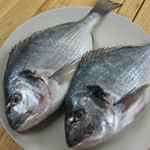 Although it does not grow to any great size, the black bream is generally regarded as a particularly tricky and prized fish to catch. The current British record is 2.24Kg. Black bream are not generally a concern to conservationists and they can be found in huge shoals throughout much of the year. They are vulnerable to fishing during their spawning period from March – April and should not be targeted when nesting.
Although it does not grow to any great size, the black bream is generally regarded as a particularly tricky and prized fish to catch. The current British record is 2.24Kg. Black bream are not generally a concern to conservationists and they can be found in huge shoals throughout much of the year. They are vulnerable to fishing during their spawning period from March – April and should not be targeted when nesting.
Minimum size:
23cm/9½in (correct for 2020)
When to catch black bream:
Bream are resident along the South Coast from May to December. They are present earlier than this, from March in certain spots, but are spawning at this time.
Where to catch black bream:
Bream are found right along the South Coast. They tend to move from East to West as the season goes on. In Late May they arrive off Portland Bill in astonishing numbers. Its a very impressive site to see walls of migrating bream arriving on the ledges in May.
Portland offers very consistent fishing for black bream on the mussel beds all along the East side and off the Western tip, They tend to be found in wide open spaces with little natural cover.
Good numbers of bream are also seen at Kingmere, Littlehampton and off Kimmeridge. They are less common in Cornwall and Wales but can show up from time to time.
Behaviour and Hunting:
Bream tend to feed on small invertebrates and are typically to be found roaming over an open seabed in a large group. They seem to particularly favour flat rocky ledges and will usually be encountered in depths from 10m to 20m+. It is unusual (but possible) to see them shallower than 10m. A perfect depth seems to be about 14m.
Bream will usually come in quickly to have a look once a diver reaches the seabed. It is advisable to shoot immediately, as they seldom come closer for a further inspection. They are skittish and shy fish and have excellent eyesight, staying a lot further away from the diver than species such as bass and pollack.
Tricks such as scratching up the mussels or throwing up shale and pebbles can work further East on the South Coast. Off Portland these tricks do not seem to convince the bream to come closer.
We have developed the following technique for hunting bream off Portland where vast shoals comprising thousands of fish are commonly seen:
Dive to the bottom in about 14m, ideally on the mussel beds or flat ledges. Where there is no cover, adopt an agachon position. Where there is good cover, get into the cover and hide as much of your body as possible. Bream will usually approach you rapidly at an angle perpendicular to the tide, or from downtide. The most successful orientation is therefore for you to face downtide. It is important to shoot as soon as a good bream is in range. They tend to come as close as they are going to come when they first arrive.
Gun range is a major consideration as bream really like to keep their distance. Guns 75-90cm are often inadequate. Off Portland we tend to use much longer guns, 110-140cm because the water is often very clear and it is possible to shoot at ranges of up to 7m with these.
Of course where there is heavy cover or bad vis you can catch them with shorter guns.
A dive report:
“Diving down over the Portland Flats, I found myself drifting over black mussel beds at 17m- prime bream territory. The seabed was very flat and there was nothing to be seen despite the 6m vis on the bottom. I found a shallow gully lying perpendicular to the current and dropped in, out of sight. Within a few seconds a 3 pound black bream popped over the top to have a look. It had had to come much closer than usual due to the cover afforded by the little gully. A quick shot from my 90 and he was on the way to the surface with me, my first Portland Bream!”
Eating black bream:
Black bream definitely get 10/10 for their flavour and texture. They are usually an ideal pan or baking size and are superb just baked in foil for 30 minutes in a hot oven.
Weapon of choice:
Rob Allen Carbon 110 with double 16mm rubbers and 7mm spear
Dive Report 2:
“Ghosting down at 22m it was dark despite the 6m plus vis. A vast shoal of black bream whirled about like a carnival down tide of me on the mussle beds. Time was definitely ticking and as I was looking for a target in the dense mass of fish, I saw a huge gill plate moving from left to right. The size and colour suggested a 15 pound plus bass, so I lined up the 140 to fire. As I was about to shoot I saw that it was not a huge bass but a much shorter and stumpier fish. Fortunately the hit was good as it was a stuggle to bring the powerful fish up from such deep water. The very long shooting line of the 140 definitely helped. Moments later the British Record Gilthead was on the boat!”
Eating:
11/10 absolutely amazing!!!
Weapon of choice:
Rob Allen 140cm Carbon with double 16mm rubbers and 7.5mm spear
